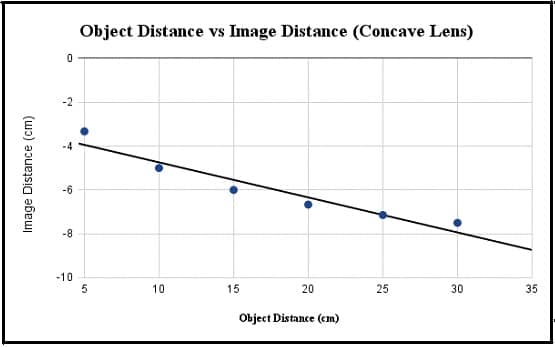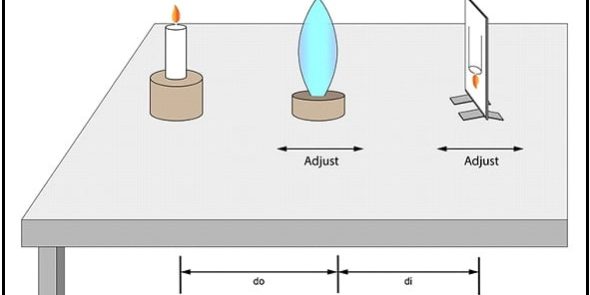PURPOSE
The purpose of the experiment is to validate the lens equation and the magnification equation by measuring the image distance from a fixed focal length and the object distance from the thin lens using concave and convex lenses.
QUESTION
How does an object’s image position and size (magnification) vary with different object distances from a convex and concave lens?
BACKGROUND KNOWLEDGE
Geometric optics (also known as ray optics) is the study of light propagation in terms of rays and how they interact with surfaces and media. In the case of lenses, the image formed by a lens depends on the distance between the object and the lens, as well as the focal length of the lens. The relationship between object distance and image distance can be described using the lens equation:
1/f = 1/do + 1/di
where f is the focal length of the lens,
do is the object distance,
di is the image distance.
In this experiment, we will be using concave and convex lenses to study the properties of an object’s: image, position, and size.
Concave Lens: A concave lens, also known as a diverging lens, is thinner at the center and thicker at the edges. It curves inward, causing light rays that pass through it to spread out or diverge. A concave lens is denoted by a negative focal length. The focal point of a concave lens is the point where the diverging rays of light appear to meet when extended back. A concave lens can be used to correct nearsightedness, as it spreads out the incoming light rays before they reach the eye’s lens, helping to focus the image properly on the retina.
Convex Lens: A convex lens, also known as a converging lens, is thicker at the center and thinner at the edges. It curves outward, causing light rays that pass through it to converge or come together. A convex lens is denoted by a positive focal length. The focal point of a convex lens is the point where the converging rays of light actually meet. Convex lenses are commonly used in everyday objects like eyeglasses, magnifying glasses, and cameras, as they can magnify and focus light to form real or virtual images.
The distance from the center of the lens to the point through which rays parallel to the optical axis meet after refraction by the lens is known as the focal point. The focal length is related to the distance between the lens and the object and also related to the distance between the lens and the image. The magnification of the lens is the ratio of the size of the image (Hi) to the size of the object (Ho). If the image produced is real and inverted, the magnification is negative. If the image is upright and virtual, the magnification is positive. A real image is formed on the opposite side of the lens from the object. A virtual image is on the same side of the lens as the object. A lens’s focal point is the point at which light rays meet after relection or refraction.
When finding where an image is formed after light is relected from an object, three lines can be drawn. The first line is drawn from the top of the object parallel to the axis of the center line of the lens. The second line is drawn from the end of the first line through the appropriate focal point. The third line is drawn from the top of the object through the center of the lens. Where lines two and three interest is where an image will be formed.
EQUATIONS
Focal Length:
f = R/2 (where f is the focal length and R is the radius/center of curvature) Lens Equation:
1/f = 1/do + 1/di (where f is the focal length, do is the distance of the object, and di is the distance of the image)
Magnification:
M = hi/ho = -di/do (where hi is the height of the image, ho is the height of the object, di is the distance of the image, do is the distance of the object)
HYPOTHESIS
Based on the thin lens equation and the background knowledge, we hypothesize that by manipulating the object distance, image distance, and focal length of a thin lens, we can predict and calculate the image location, size, and magnification of an object. We expect that when the object distance and image distance are varied while keeping the focal length constant, the image location and size will change accordingly, following the thin lens equation.
We further hypothesize that the magnification of the image, which represents the size of the image relative to the size of the object, will be influenced by the object distance, image distance, and focal length of the lens. We anticipate that the magnification will vary depending on the values of the object distance, image distance, and focal length, as predicted by the thin lens equation.
MATERIALS
- Convex Lens
- Concave Lens
- Lens holder
- Candle
- Matches
- Screen
- Screen clamp
- Meter stick
- Meter stick holder
PROCEDURE
- Place a meter stick on a lat surface like a table, with holders on both ends of the stick to keep it in place.
- Set up a screen on a clamp using a sheet of paper on one side of the meter stick.
- Place a concave or convex lens on top of a lens holder at exactly 50cm, as this is the center of the stick and will provide enough room on both sides for adjustment.
- Place a candle inside a candle holder and put it 5cm behind the lens on the opposite side of the screen and light the candle.
- Adjust the position of the candle and screen to produce a focal length of 10cm and then adjust the position of the screen until a clear image is formed.
- Record the distance from the lens to the object as do, the distance from the lens to the image as di, and write it down in a table.
- Repeat this 5 more times with different object distances, going up by 5 each time until you reach a distance of 30cm.
- Once finished, use the lens equation, 1/f = 1/do + 1/di, to verify if the values for do and di give you the focal length when substituted in the equation.
- After all the values are determined, use the magnification equation to determine the magnification of the image for each of the different object distances.
- Repeat this procedure for both lenses and create two graphs that show the correlation between the object distance and the image distance for both lenses
DATA
Quantitative Observations using Convex Lens:
| Object Distance (cm) | Image Distance (cm) | Focal Length (cm) (1/f = 1/do + 1/di) | Magnification (-di/do) |
| 5 | -10 | 10 | 2 |
| 10 | -Infinity | 10 | Infinitely Enlarged |
| 15 | 30 | 10 | 2 |
| 20 | 20 | 10 | 1 |
| 25 | 16.667 | 10 | 0.667 |
| 30 | 15 | 10 | 0.5 |
Quantitative Observations using Concave Lens:
| Object Distance (cm) | Image Distance (cm) | Focal Length (cm) (1/f = 1/do + 1/di) | Magnification (-di/do) |
| 5 | -3.33 | -10 | 0.67 |
| 10 | -5 | -10 | 0.5 |
| 15 | -6 | -10 | 0.4 |
| 20 | -6.667 | -10 | 0.33 |
| 25 | -7.143 | -10 | 0.286 |
| 30 | -7.5 | -10 | 0.25 |
ANALYSIS


- y represents the dependent variable, Image Distance, in centimeters
- x represents the independent variable, Object Distance, in centimeters
This graph shows a stronger negative linear relationship, and it can be understood there is also a directly proportional relationship. This is because, although the image distance is in negatives as the image produced is behind the lens, the distance from the lens is still increasing as the distance of the object also increases away from the lens.
DISCUSSION
As a result of conducting this experiment, an inversely proportional relationship between the object distance and image distance was proved for convex lenses. A directly proportional relationship was also proved for concave lenses. These discoveries weren’t a surprise as the goal was to prove the thin lens equation.
Experimental Errors & Limitations:
As with any experimental setup, several sources of error can affect the results’ accuracy and reliability. Here are three sources of error specific to an optic experiment like this.
Misalignment of the optical components: In an optics experiment, the position and orientation of the lenses, mirrors, and other optical components must be precisely adjusted to obtain accurate results. Even a small misalignment can cause significant errors in the measurements, leading to incorrect conclusions.
Environmental factors: Environmental factors such as temperature, humidity, and air currents can affect the properties of the optical components and the behavior of light passing through them. These factors can cause changes in the refractive index, scattering, and light absorption, leading to measurement errors.
Imperfections in the optical components: No optical component is perfect, and imperfections such as scratches, bubbles, and impurities can affect the properties of light passing through them. In this case, imperfections in convex or concave lenses can cause distortions, aberrations, and other effects that can lead to errors in the measurements recorded. To minimize these errors, it is essential to carefully calibrate the experimental setup, use high-quality optical components, and control the environmental conditions as much as possible. Additionally, it is crucial to perform repeated measurements and analyze the data statistically to account for random errors and obtain more accurate results.
CONCLUSION
Upon completion of this experiment, it was demonstrated that the relationship between the object’s distance and its image’s distance is inversely proportional for convex lenses and directly proportional for concave lenses. This confirmed the hypothesis as the object’s image did vary and decrease for convex lenses, while increasing with concave lenses. This experiment also verified the lens equation and the magnification equation through the use of the analysis and data. However, this study is restricted to the range of distances between 5cm to 30cm and no accurate predictions can be made for values outside this. The experiment could be extended by investigating the effect of changing the focal length of the lens on the relationship between object distance and image distance and could be improved by using more precise instruments or by repeating the experiment several times to obtain a more accurate average value of the distances.

